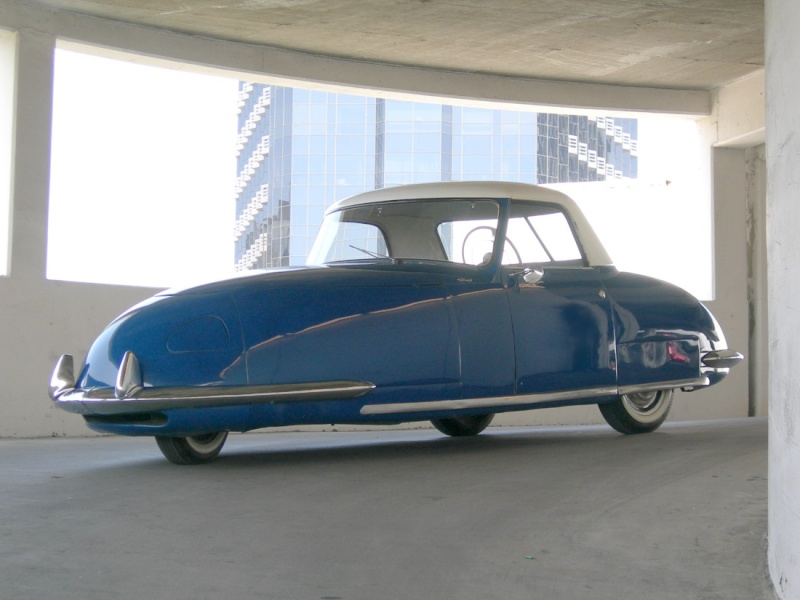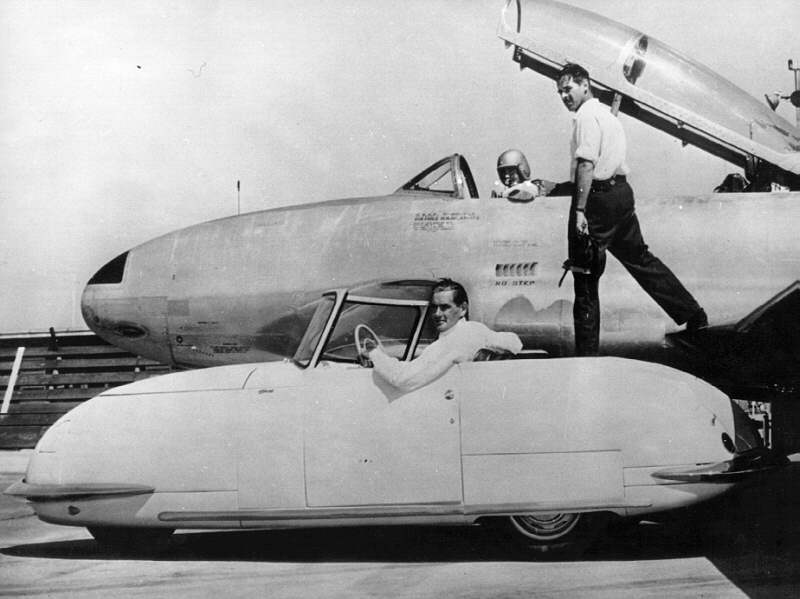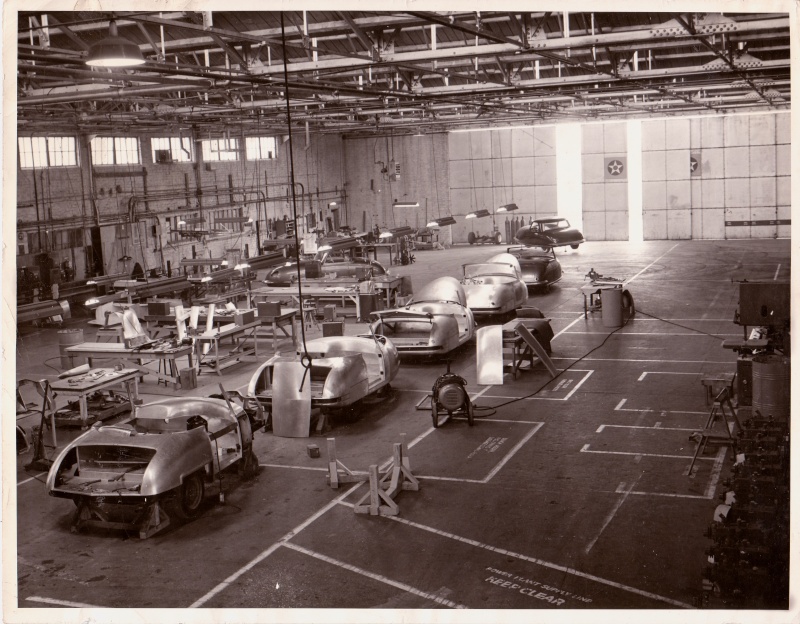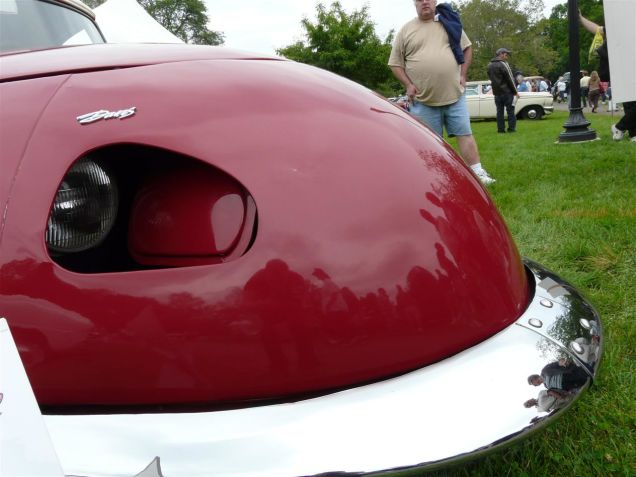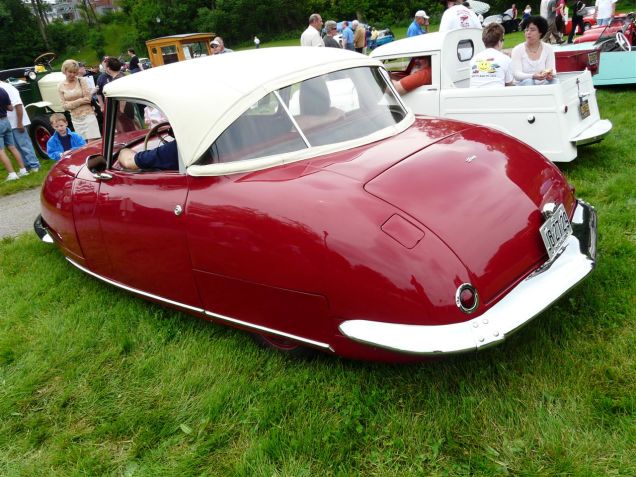1948 Davis Three Wheels
2 participants
 1948 Davis Three Wheels
1948 Davis Three Wheels
Dernière édition par Predicta le Lun 4 Mai - 21:59, édité 1 fois
_________________
We don't care the People Says , Rock 'n' roll is here to stay - Danny & the Juniors - 1958
 Re: 1948 Davis Three Wheels
Re: 1948 Davis Three Wheels
_________________
We don't care the People Says , Rock 'n' roll is here to stay - Danny & the Juniors - 1958
 Re: 1948 Davis Three Wheels
Re: 1948 Davis Three Wheels
_________________
We don't care the People Says , Rock 'n' roll is here to stay - Danny & the Juniors - 1958
 Re: 1948 Davis Three Wheels
Re: 1948 Davis Three Wheels
_________________
We don't care the People Says , Rock 'n' roll is here to stay - Danny & the Juniors - 1958
 Re: 1948 Davis Three Wheels
Re: 1948 Davis Three Wheels
Those of us who were around in the immediate aftermath of World War II can recall, fondly or otherwise, the explosive frenzy that swept the nation when it came to cars. The United States wasn't far removed from the Depression when it was plunged into conflict that forced widespread self-denial on the home front, with everything from sugar to gasoline strictly rationed by the government. Buying a car, even a used one, was out of the question, and wartime motorists doddered along in pre-war cars barely kept functional, on perpetually patched tires. As a result, once the surrender papers were signed aboard the U.S.S. Missouri in Tokyo Harbor, Americans wanted new cars. Now. No, make that yesterday. Any car, just as long as it was new or at least reliable.

That fevered marketplace was the impetus for a welter of would-be manufacturers to scurry into the marketplace after 1945, like cockroaches bolt when you flip on the light in a dark, damp room. We can't even call these builders Independents, at least in the collector-car context of that term, because they occupied-or tried to-much smaller niches. Or in some cases, niches that never existed in the first place. Convinced that car-starved Americans would buy anything with wheels and an engine, a slew of backyard mechanics, freethinkers and outright hustlers tried to translate their visions into metal. Some of the cars, most notably the Henry J/Allstate, Crosley and King Midget, enjoyed measurable sales success. Others never got past a single prototype that was pitched to potential investors. Some didn't even make it that far.
Not since the industry's earliest years were such a bizarre, head-scratching variety of vehicles conceptualized. In 1948, a Kansas City entrepreneur introduced the Gregory, a rear-engine, front-drive sedan that looked most like a shorted Saab 92. The prototype was also the last one built. Then there was the Gadabout, a three-passenger roadster on an MG chassis that largely resembled a beached, shorn platypus. Another proposal was the Pup, a tiny, two-passenger runabout that could have just as well been made by Fisher-Price.
It was this wacky environment that spawned our feature car, a 1948 Davis Divan. For the record, "divan" is an Arabic-derived noun that means a large couch or day bed. Its shape and proportions would make one wonder whether it was Steve Jobs's inspiration for the computer mouse. As if its looks weren't strange enough, consider its layout. It had only a single front wheel, mounted in a yoke with two coil springs, like the nose gear of a Forties airplane. Yet the California-built Davis's convoluted history stretches all the way back to Gasoline Alley at the Indianapolis Motor Speedway.
Arguably, the true father of the Davis was Joel Thorne, a wealthy, if somewhat eccentric, millionaire sportsman from Southern California who was active on the national racing scenes as early as the mid-Thirties, his car usually running respectably at Indianapolis. Thorne himself finished ninth as a rookie in 1938. Driving a Thorne Engineering car, George Robson won the first post-war Indy 500 in 1946. At that point, the foreman of Thorne Engineering's metalworking shop in Burbank was Frank Kurtis, a gifted artisan who would later form Kurtis-Kraft and create all-conquering Indianapolis roadsters and short-track midgets, in addition to a fling with a production car of his own.
But we're getting ahead of the story. Sometime in 1941, Thorne asked Kurtis to build him a personal roadster that was different. Kurtis certainly delivered the goods: He came up with a three-wheeled car powered by a Ford V-8/60 flathead with a single steerable wheel at the rear. The configuration proved all but uncontrollable at highway speeds. The aircraft industry was already well established in Los Angeles, and Kurtis took notice that planes with steerable tail wheels could turn in nearly their own length. He quickly swapped the layout of the roadster's drive and steering wheels, and presented the car, which he dubbed the Californian, to Thorne, who was delighted with it, and drove it through the end of the war despite wrecking it several times.

From here, the precise sequence of events remains unclear, but this much is certain: In late 1945, Thorne made the acquaintance of Glenn Gordon "Gary" Davis, a self-proclaimed industrial designer but, in reality, a high-energy car salesman who had landed in Los Angeles after having operated used-car lots in his native Indiana. He immediately hatched a plan to peddle the Californian to Hollywood types as a novelty car, and convinced Thorne to sell it to him-or as another account claims, borrowed it for a test drive and staged an accident, whereupon Thorne simply gave him the car. Davis dashed off with the little car, his busy brain already cooking up a wild series of publicity grabs likely unseen since Carl G. Fisher floated lazily over Indianapolis in a Stoddard-Dayton suspended from a hot-air balloon.
If nothing else, Davis had unparalleled ability to grab people's attention by the very throat and hold it in a rigid death grip. In rapid-fire succession, he convinced Business Week to do a feature on the car, which he had now modestly named after himself, with a Hollywood starlet behind the wheel. Davis claimed to have been designing the car himself for several years. Kurtis was never mentioned in the story. Next, Life magazine featured the renamed Davis in a photo feature on booming post-war California. He also managed to get it shown in a newsreel that ran in movie theaters nationwide. It also appeared in most TV episodes of the short-lived, syndicated detective program, The Cases of Eddie Drake. Throughout the publicity blitz, Davis never failed to mention that he planned to take the car to production and sell it for $1,000.
All the hype resulted in Davis being barraged with mail from eager would-be buyers-and investors. He hired a Beverly Hills photographer to take publicity shots, who suggested they drive the car together to Chicago where he had relatives. After the road trip, mail continued to pour in, among it queries from would-be dealers who wanted franchises to sell the car. The checks started pouring in, so Davis rented a building at the Van Nuys Airport as his factory. By this time, Kurtis's original car had all but disintegrated. The photographer, Joe Charipar, introduced Davis to several engineers and designers, who Davis promised to pay double salary once the cars began selling if they would design and build them initially for free. The first running prototype actually built by the Davis Motorcar Co., known as the Baby and bearing no Davis script, was displayed in November 1947 at the Ambassador Hotel in Los Angeles. From there, it was shipped east to a Christmas pageant outside a Philadelphia department store, and a Davis then headed the Tournament of Roses parade in Pasadena, California, on New Year's Day 1948. A second prototype, with a removable hardtop and known as Delta by the workers, followed soon after.
The third car produced was the first to actually carry the Davis script. Despite the eyeblink-brief production run, the Davis three-wheeler actually underwent some major running changes as it unfolded. The first was to jettison the tubular space frame of the Baby prototype in favor of a conventional channel steel frame that was cheaper and quicker to fabricate. The second was to switch from Hercules to Continental engines. Most of the Davis bodies were assembled in aircraft fashion, with the aluminum/zinc panels hammered out on dies made of relatively soft kirksite alloy. The 11 panels were attached to the chassis by a combination of welding and bolting. Most other components came off the shelf, including the Borg-Warner three-speed manual gearbox, Spicer differential and steering gear, and even the door latch pushbuttons; they came from the same supplier that made them for Lincolns. As for the nose wheel assembly, it was first welded from multiple pieces, but was later made from a single casting, in a wooden mold, from iron produced through the meehanite process, which optimizes the casting's structural or "matrix" strength.
The Davis was innovative in a less obvious respect: It had built-in jacks at each wheel, fabricated with military-surplus hydraulic cylinders. Despite the influx of working capital from the burgeoning excitement, the fledgling automaker was clearly hanging on by a thread. Well into 1948, the employees still hadn't been paid.
Still, the promotional blitz went on, with Davis claiming the car could execute a full-lock U-turn at 55 mph. A film showing the Davis in action was produced, and in January 1949, the Davis was the topic of a cover story in PARADE magazine, an insert in numerous Sunday newspapers that was routinely read by millions. Behind the ballyhoo, though, were ominous rumblings: The Los Angeles County district attorney was investigating complaints from dealers who had paid Davis up front for franchises but received no cars. In May, Davis's employees filed suit demanding nearly $190,000 in his promised "doubled" wages from the vast franchise fees Davis had already raked in. Days later, he closed the Van Nuys plant. Within weeks, one dealer repossessed seven of the cars. In November 1949, the district attorney obtained a warrant and seized both the company's and Davis's personal financial records. Next, the firm's remaining components and assets were seized and liquidated to satisfy tax liens.
Davis was ultimately charged with 28 counts of grand theft and fraud for mishandling an estimated $2 million in franchise fees. When the case went to trial in late 1950, Deputy District Attorney Mark Brandler-who, as a judge in 1963, would preside over the notorious "Onion Field" police-killing trial-argued that Davis had never intended to build cars at all, but was using the fees to buy a house, furnishings and luxury cars for himself, all the while paying himself $1,000 a week in salary. Davis was convicted in January 1951, served two years in a county prison camp and then moved to Palm Springs, where he still dabbled in trying to promote the idea of cars with unusual wheel arrangements before dying of emphysema in 1973.
By his own admission, Tom Wilson of Ypsilanti, Michigan, has been chasing the failed dream of Davis for close to 40 years. He holds a singular distinction in the collector-car hobby: Tom is the only collector in the world to own more than one Davis, a yellow one believed to be the third Davis built. He discovered it in 1965, sitting on a wooded lot near the Ohio border that was strewn with other abandoned cars, broken furniture and junked appliances. The lot and its contents had been abandoned by its previous owner. Tom obtained a salvage title, dragged the car home and undertook a 20-year restoration that might better be described as what scale modelers call "kitbashing," mixing parts from various kits to arrive at a desired result. Since replacement parts for Davises are nonexistent, resourceful scrounging is necessary when restoring one. Tom's first Davis, the sixth built, now has a Willys driveline. At least one surviving Davis was retrofitted with a six-cylinder Nash Statesman engine.
His second Davis, our feature car, is this green 1948 Divan with removable hardtop and serial number 13, very possibly the last one ever built. Tom spotted it, purely by chance, sitting outdoors near Lakewood, Colorado, during a 1986 trip across the West. He and his wife, Vivian, bought it in 1989 from the executor of the previous owner's estate, who had been presented with the Davis by the grateful heirs. The car was rough, but unlike the first Davis, it was fairly complete, still with its original L-head Continental four-cylinder engine and the rest of the powertrain.
"It was dented all over, and the left side of the cowl was all banged in," he said. "I'd guess the chrome was 50 to 75 percent rusted. It was complete, but it was just battered up."

About the only thing missing was a side chrome spear, and to replace it, Tom had to improvise. He measured the remaining spear, went to a swap meet, and found some replacement chrome. As he explained, "I got the closest thing I could find. It's a little wider than the original, and it's in two pieces, but nobody ever notices. I also had to fabricate headlamp doors two different times. I just got some sheet aluminum and banged away on it until I got it right."
Tom used to drive his older Davis somewhat regularly, but now admits to worry about using them in traffic, and can neither confirm nor debunk Davis's claim about the 55-mph U-turn. He explained, "They're so rare, and there are so few of them restored in any case, that I figure it's better to be careful. I take the green one to maybe one cruise night every summer.
"With these cars, though, maneuverability is the key. The turning radius is only about 15 feet. I built a 30-by-30 garage, drove inside, did a U-turn and drove back out. I don't think I've ever had either car above 65 mph, but it's quick, the engine really is a hot rod four-banger. The brakes are fine; it was all Bendix stuff, and the master cylinder's interchangeable with all the post-war Independents. When the Davis was first built, it had Model A Ford friction shocks, but I replaced them with N.O.S. Corvette tubular shocks, so it rides pretty good.
"There's just one thing: You have to be really careful with that single front wheel. If you hit a pothole or a railroad track, believe me, it can be pretty brain-jarring."

Where are they now?
Given the tiny handful of Davis cars that ever existed, it stands to reason that their current locations should be fairly easy to track. Tom Wilson has done so by creating a registry for Davis automobiles, and believes he has solid information on their current whereabouts and conditions. Plus, the world of Davis fans is small and tight out of necessity. Here's the lineup, based on the cars' serial numbers.
#1 The Baby prototype, in the hands of a Wisconsin collector
#2 The Delta prototype, in Michigan, undergoing restoration
#3 The first "true" Davis, in Michigan but unrestored
#4 Part of the Petersen Automotive Museum collection in Los Angeles
#5 Shipped to Great Britain to show potential dealers; later destroyed under British customs laws
#6 Tom Wilson's first Davis, now with Henry J powertrain
#7 On exhibit in the Southward Car Museum in Paraparaumu, New Zealand
#8 Unrestored, located in Lumberton, North Carolina
#9 Restored, owned by a Los Angeles personal trainer for entertainment figures
#10 Unrestored, in pieces, located in Kansas
#11 Restored, retrofitted with a Nash straight-six, in West Chester, Pennsylvania
#12 Unrestored, disassembled, located in Florida
#13 Tom Wilson's second Davis, possibly the last one built, restored with original Continental engine
OWNER'S VIEW
What made Tom Wilson, a retired teacher, rescue an obscure, maybe even bizarre, orphaned car from an abandoned dump? When he spotted it on the way to his teaching job nearly 40 years ago, it triggered a flashback to his youth.
"We used to make these scrapbooks out of magazine ads when we were kids, and I knew it looked like one of those little cars built after the Second World War," he said. "I was into Kaiser-Frazer cars, but I liked this.
"It's the uniqueness that I like most," Tom explained. "People always marvel at the Tucker, but I actually think that's an ugly car. The Davis is a very pretty car. It's maneuverable, it's roomy, you really can fit four people across the front seat, and it really moves. It's the consummate novelty antique. It's got everything."
While we were preparing this story, Tom turned 69 and got the birthday gift of his dreams. It's one of the three prototype Davis jeeps ever made, discovered in Georgia through a contact on the Davis registry Tom runs. It was on its way to Michigan as we spoke.
"I can't wait for it to get here," he gushed. "I'll be as excited as a kid with a new toy."
SPECIFICATIONS
Base price: $995
ENGINE
Type: Continental 4162 L-head inline-four, cast-iron block and head
Displacement: 162.4 cubic inches
Bore x Stroke: 3.44 x 4.37 inches
Horsepower @ rpm: 63 @ 3,200
Torque @ rpm: 125-lbs.ft. @ 1,750
Compression ratio: 6.46:1
Valvetrain: Mechanical tappets
Main Bearings: 3
Fuel System: Stromberg downdraft one-barrel carburetor; camshaft-driven mechanical fuel pump
Ignition System: Battery and distributor
Electrical System: 6-volt
Exhaust System: Single exhaust
TRANSMISSION
Type: Borg-Warner three-speed manual, column shift, Auburn 8.5-inch dry plate clutch
Ratios 1st: 2.60:1
2nd: 1.63:1
3rd: 1.00:1
Reverse: N/A
DIFFERENTIAL
Type: Spicer open shaft, dual universal joints
Ratio: 4.10:1
STEERING
Type: Gemmer worm and gear
Ratio: 18.0:1
Turns, lock-to-lock: 4.75
Turning Circle: 12.7 feet
BRAKES
Type: Bendix hydraulic, manual
Front: 10-inch expanding drum
Rear: 10-inch expanding drums
CHASSIS & BODY
Construction: Steel-channel frame, aluminum body panels
Body Style: Two-door convertible
Layout: Front-engine, rear-wheel drive
SUSPENSION
Front: Y-yoke, dual coil springs, dual outrigged double-action tubular shocks
Rear: Live axle, semi-elliptic leaf springs, single-action tubular shocks
WHEELS & TIRES
Wheels: Pressed steel discs
Front: 15 x 4.5 inches
Rear: 15 x 4.5 inches
Tires: Coker four-ply whitewalls
Front: 6.50 x 15
Rear: 6.50 x 15
WEIGHTS & MEASURES
Wheelbase: 109.5 inches
Overall Length: 183.5 inches
Overall Width: 72.0 inches
Overall Height: 60.0 inches
Front Track: N/A
Rear Track: 57.7 inches
Shipping Weight: 2,450 pounds
CAPACITIES
Crankcase: 4 quarts
Cooling System: 11 quarts
Fuel Tank: 18 gallons
CALCULATED DATA
Bhp per c.i.d: 0.39
Weight per bhp: 38.89 pounds
Weight per c.i.d.: 15.12 pounds
PERFORMANCE
Fuel consumption: 35 mpg (est.)
PRODUCTION
Total: 16
Prototypes: 2
Coupes: 11 known
Military: 3 known
PROS
The epitome of exclusivity
It's a genuinely innovative automobile
You'll stop traffic everywhere you go
CONS
Spares? N.O.S.? What's that?
Wobbly handling under some conditions
Grim company history
This article originally appeared in the April, 2005 issue of Hemmings Classic Car.

That fevered marketplace was the impetus for a welter of would-be manufacturers to scurry into the marketplace after 1945, like cockroaches bolt when you flip on the light in a dark, damp room. We can't even call these builders Independents, at least in the collector-car context of that term, because they occupied-or tried to-much smaller niches. Or in some cases, niches that never existed in the first place. Convinced that car-starved Americans would buy anything with wheels and an engine, a slew of backyard mechanics, freethinkers and outright hustlers tried to translate their visions into metal. Some of the cars, most notably the Henry J/Allstate, Crosley and King Midget, enjoyed measurable sales success. Others never got past a single prototype that was pitched to potential investors. Some didn't even make it that far.
Not since the industry's earliest years were such a bizarre, head-scratching variety of vehicles conceptualized. In 1948, a Kansas City entrepreneur introduced the Gregory, a rear-engine, front-drive sedan that looked most like a shorted Saab 92. The prototype was also the last one built. Then there was the Gadabout, a three-passenger roadster on an MG chassis that largely resembled a beached, shorn platypus. Another proposal was the Pup, a tiny, two-passenger runabout that could have just as well been made by Fisher-Price.
It was this wacky environment that spawned our feature car, a 1948 Davis Divan. For the record, "divan" is an Arabic-derived noun that means a large couch or day bed. Its shape and proportions would make one wonder whether it was Steve Jobs's inspiration for the computer mouse. As if its looks weren't strange enough, consider its layout. It had only a single front wheel, mounted in a yoke with two coil springs, like the nose gear of a Forties airplane. Yet the California-built Davis's convoluted history stretches all the way back to Gasoline Alley at the Indianapolis Motor Speedway.
Arguably, the true father of the Davis was Joel Thorne, a wealthy, if somewhat eccentric, millionaire sportsman from Southern California who was active on the national racing scenes as early as the mid-Thirties, his car usually running respectably at Indianapolis. Thorne himself finished ninth as a rookie in 1938. Driving a Thorne Engineering car, George Robson won the first post-war Indy 500 in 1946. At that point, the foreman of Thorne Engineering's metalworking shop in Burbank was Frank Kurtis, a gifted artisan who would later form Kurtis-Kraft and create all-conquering Indianapolis roadsters and short-track midgets, in addition to a fling with a production car of his own.
But we're getting ahead of the story. Sometime in 1941, Thorne asked Kurtis to build him a personal roadster that was different. Kurtis certainly delivered the goods: He came up with a three-wheeled car powered by a Ford V-8/60 flathead with a single steerable wheel at the rear. The configuration proved all but uncontrollable at highway speeds. The aircraft industry was already well established in Los Angeles, and Kurtis took notice that planes with steerable tail wheels could turn in nearly their own length. He quickly swapped the layout of the roadster's drive and steering wheels, and presented the car, which he dubbed the Californian, to Thorne, who was delighted with it, and drove it through the end of the war despite wrecking it several times.

From here, the precise sequence of events remains unclear, but this much is certain: In late 1945, Thorne made the acquaintance of Glenn Gordon "Gary" Davis, a self-proclaimed industrial designer but, in reality, a high-energy car salesman who had landed in Los Angeles after having operated used-car lots in his native Indiana. He immediately hatched a plan to peddle the Californian to Hollywood types as a novelty car, and convinced Thorne to sell it to him-or as another account claims, borrowed it for a test drive and staged an accident, whereupon Thorne simply gave him the car. Davis dashed off with the little car, his busy brain already cooking up a wild series of publicity grabs likely unseen since Carl G. Fisher floated lazily over Indianapolis in a Stoddard-Dayton suspended from a hot-air balloon.
If nothing else, Davis had unparalleled ability to grab people's attention by the very throat and hold it in a rigid death grip. In rapid-fire succession, he convinced Business Week to do a feature on the car, which he had now modestly named after himself, with a Hollywood starlet behind the wheel. Davis claimed to have been designing the car himself for several years. Kurtis was never mentioned in the story. Next, Life magazine featured the renamed Davis in a photo feature on booming post-war California. He also managed to get it shown in a newsreel that ran in movie theaters nationwide. It also appeared in most TV episodes of the short-lived, syndicated detective program, The Cases of Eddie Drake. Throughout the publicity blitz, Davis never failed to mention that he planned to take the car to production and sell it for $1,000.
All the hype resulted in Davis being barraged with mail from eager would-be buyers-and investors. He hired a Beverly Hills photographer to take publicity shots, who suggested they drive the car together to Chicago where he had relatives. After the road trip, mail continued to pour in, among it queries from would-be dealers who wanted franchises to sell the car. The checks started pouring in, so Davis rented a building at the Van Nuys Airport as his factory. By this time, Kurtis's original car had all but disintegrated. The photographer, Joe Charipar, introduced Davis to several engineers and designers, who Davis promised to pay double salary once the cars began selling if they would design and build them initially for free. The first running prototype actually built by the Davis Motorcar Co., known as the Baby and bearing no Davis script, was displayed in November 1947 at the Ambassador Hotel in Los Angeles. From there, it was shipped east to a Christmas pageant outside a Philadelphia department store, and a Davis then headed the Tournament of Roses parade in Pasadena, California, on New Year's Day 1948. A second prototype, with a removable hardtop and known as Delta by the workers, followed soon after.
The third car produced was the first to actually carry the Davis script. Despite the eyeblink-brief production run, the Davis three-wheeler actually underwent some major running changes as it unfolded. The first was to jettison the tubular space frame of the Baby prototype in favor of a conventional channel steel frame that was cheaper and quicker to fabricate. The second was to switch from Hercules to Continental engines. Most of the Davis bodies were assembled in aircraft fashion, with the aluminum/zinc panels hammered out on dies made of relatively soft kirksite alloy. The 11 panels were attached to the chassis by a combination of welding and bolting. Most other components came off the shelf, including the Borg-Warner three-speed manual gearbox, Spicer differential and steering gear, and even the door latch pushbuttons; they came from the same supplier that made them for Lincolns. As for the nose wheel assembly, it was first welded from multiple pieces, but was later made from a single casting, in a wooden mold, from iron produced through the meehanite process, which optimizes the casting's structural or "matrix" strength.
The Davis was innovative in a less obvious respect: It had built-in jacks at each wheel, fabricated with military-surplus hydraulic cylinders. Despite the influx of working capital from the burgeoning excitement, the fledgling automaker was clearly hanging on by a thread. Well into 1948, the employees still hadn't been paid.
Still, the promotional blitz went on, with Davis claiming the car could execute a full-lock U-turn at 55 mph. A film showing the Davis in action was produced, and in January 1949, the Davis was the topic of a cover story in PARADE magazine, an insert in numerous Sunday newspapers that was routinely read by millions. Behind the ballyhoo, though, were ominous rumblings: The Los Angeles County district attorney was investigating complaints from dealers who had paid Davis up front for franchises but received no cars. In May, Davis's employees filed suit demanding nearly $190,000 in his promised "doubled" wages from the vast franchise fees Davis had already raked in. Days later, he closed the Van Nuys plant. Within weeks, one dealer repossessed seven of the cars. In November 1949, the district attorney obtained a warrant and seized both the company's and Davis's personal financial records. Next, the firm's remaining components and assets were seized and liquidated to satisfy tax liens.
Davis was ultimately charged with 28 counts of grand theft and fraud for mishandling an estimated $2 million in franchise fees. When the case went to trial in late 1950, Deputy District Attorney Mark Brandler-who, as a judge in 1963, would preside over the notorious "Onion Field" police-killing trial-argued that Davis had never intended to build cars at all, but was using the fees to buy a house, furnishings and luxury cars for himself, all the while paying himself $1,000 a week in salary. Davis was convicted in January 1951, served two years in a county prison camp and then moved to Palm Springs, where he still dabbled in trying to promote the idea of cars with unusual wheel arrangements before dying of emphysema in 1973.
By his own admission, Tom Wilson of Ypsilanti, Michigan, has been chasing the failed dream of Davis for close to 40 years. He holds a singular distinction in the collector-car hobby: Tom is the only collector in the world to own more than one Davis, a yellow one believed to be the third Davis built. He discovered it in 1965, sitting on a wooded lot near the Ohio border that was strewn with other abandoned cars, broken furniture and junked appliances. The lot and its contents had been abandoned by its previous owner. Tom obtained a salvage title, dragged the car home and undertook a 20-year restoration that might better be described as what scale modelers call "kitbashing," mixing parts from various kits to arrive at a desired result. Since replacement parts for Davises are nonexistent, resourceful scrounging is necessary when restoring one. Tom's first Davis, the sixth built, now has a Willys driveline. At least one surviving Davis was retrofitted with a six-cylinder Nash Statesman engine.
His second Davis, our feature car, is this green 1948 Divan with removable hardtop and serial number 13, very possibly the last one ever built. Tom spotted it, purely by chance, sitting outdoors near Lakewood, Colorado, during a 1986 trip across the West. He and his wife, Vivian, bought it in 1989 from the executor of the previous owner's estate, who had been presented with the Davis by the grateful heirs. The car was rough, but unlike the first Davis, it was fairly complete, still with its original L-head Continental four-cylinder engine and the rest of the powertrain.
"It was dented all over, and the left side of the cowl was all banged in," he said. "I'd guess the chrome was 50 to 75 percent rusted. It was complete, but it was just battered up."

About the only thing missing was a side chrome spear, and to replace it, Tom had to improvise. He measured the remaining spear, went to a swap meet, and found some replacement chrome. As he explained, "I got the closest thing I could find. It's a little wider than the original, and it's in two pieces, but nobody ever notices. I also had to fabricate headlamp doors two different times. I just got some sheet aluminum and banged away on it until I got it right."
Tom used to drive his older Davis somewhat regularly, but now admits to worry about using them in traffic, and can neither confirm nor debunk Davis's claim about the 55-mph U-turn. He explained, "They're so rare, and there are so few of them restored in any case, that I figure it's better to be careful. I take the green one to maybe one cruise night every summer.
"With these cars, though, maneuverability is the key. The turning radius is only about 15 feet. I built a 30-by-30 garage, drove inside, did a U-turn and drove back out. I don't think I've ever had either car above 65 mph, but it's quick, the engine really is a hot rod four-banger. The brakes are fine; it was all Bendix stuff, and the master cylinder's interchangeable with all the post-war Independents. When the Davis was first built, it had Model A Ford friction shocks, but I replaced them with N.O.S. Corvette tubular shocks, so it rides pretty good.
"There's just one thing: You have to be really careful with that single front wheel. If you hit a pothole or a railroad track, believe me, it can be pretty brain-jarring."

Where are they now?
Given the tiny handful of Davis cars that ever existed, it stands to reason that their current locations should be fairly easy to track. Tom Wilson has done so by creating a registry for Davis automobiles, and believes he has solid information on their current whereabouts and conditions. Plus, the world of Davis fans is small and tight out of necessity. Here's the lineup, based on the cars' serial numbers.
#1 The Baby prototype, in the hands of a Wisconsin collector
#2 The Delta prototype, in Michigan, undergoing restoration
#3 The first "true" Davis, in Michigan but unrestored
#4 Part of the Petersen Automotive Museum collection in Los Angeles
#5 Shipped to Great Britain to show potential dealers; later destroyed under British customs laws
#6 Tom Wilson's first Davis, now with Henry J powertrain
#7 On exhibit in the Southward Car Museum in Paraparaumu, New Zealand
#8 Unrestored, located in Lumberton, North Carolina
#9 Restored, owned by a Los Angeles personal trainer for entertainment figures
#10 Unrestored, in pieces, located in Kansas
#11 Restored, retrofitted with a Nash straight-six, in West Chester, Pennsylvania
#12 Unrestored, disassembled, located in Florida
#13 Tom Wilson's second Davis, possibly the last one built, restored with original Continental engine
OWNER'S VIEW
What made Tom Wilson, a retired teacher, rescue an obscure, maybe even bizarre, orphaned car from an abandoned dump? When he spotted it on the way to his teaching job nearly 40 years ago, it triggered a flashback to his youth.
"We used to make these scrapbooks out of magazine ads when we were kids, and I knew it looked like one of those little cars built after the Second World War," he said. "I was into Kaiser-Frazer cars, but I liked this.
"It's the uniqueness that I like most," Tom explained. "People always marvel at the Tucker, but I actually think that's an ugly car. The Davis is a very pretty car. It's maneuverable, it's roomy, you really can fit four people across the front seat, and it really moves. It's the consummate novelty antique. It's got everything."
While we were preparing this story, Tom turned 69 and got the birthday gift of his dreams. It's one of the three prototype Davis jeeps ever made, discovered in Georgia through a contact on the Davis registry Tom runs. It was on its way to Michigan as we spoke.
"I can't wait for it to get here," he gushed. "I'll be as excited as a kid with a new toy."
SPECIFICATIONS
Base price: $995
ENGINE
Type: Continental 4162 L-head inline-four, cast-iron block and head
Displacement: 162.4 cubic inches
Bore x Stroke: 3.44 x 4.37 inches
Horsepower @ rpm: 63 @ 3,200
Torque @ rpm: 125-lbs.ft. @ 1,750
Compression ratio: 6.46:1
Valvetrain: Mechanical tappets
Main Bearings: 3
Fuel System: Stromberg downdraft one-barrel carburetor; camshaft-driven mechanical fuel pump
Ignition System: Battery and distributor
Electrical System: 6-volt
Exhaust System: Single exhaust
TRANSMISSION
Type: Borg-Warner three-speed manual, column shift, Auburn 8.5-inch dry plate clutch
Ratios 1st: 2.60:1
2nd: 1.63:1
3rd: 1.00:1
Reverse: N/A
DIFFERENTIAL
Type: Spicer open shaft, dual universal joints
Ratio: 4.10:1
STEERING
Type: Gemmer worm and gear
Ratio: 18.0:1
Turns, lock-to-lock: 4.75
Turning Circle: 12.7 feet
BRAKES
Type: Bendix hydraulic, manual
Front: 10-inch expanding drum
Rear: 10-inch expanding drums
CHASSIS & BODY
Construction: Steel-channel frame, aluminum body panels
Body Style: Two-door convertible
Layout: Front-engine, rear-wheel drive
SUSPENSION
Front: Y-yoke, dual coil springs, dual outrigged double-action tubular shocks
Rear: Live axle, semi-elliptic leaf springs, single-action tubular shocks
WHEELS & TIRES
Wheels: Pressed steel discs
Front: 15 x 4.5 inches
Rear: 15 x 4.5 inches
Tires: Coker four-ply whitewalls
Front: 6.50 x 15
Rear: 6.50 x 15
WEIGHTS & MEASURES
Wheelbase: 109.5 inches
Overall Length: 183.5 inches
Overall Width: 72.0 inches
Overall Height: 60.0 inches
Front Track: N/A
Rear Track: 57.7 inches
Shipping Weight: 2,450 pounds
CAPACITIES
Crankcase: 4 quarts
Cooling System: 11 quarts
Fuel Tank: 18 gallons
CALCULATED DATA
Bhp per c.i.d: 0.39
Weight per bhp: 38.89 pounds
Weight per c.i.d.: 15.12 pounds
PERFORMANCE
Fuel consumption: 35 mpg (est.)
PRODUCTION
Total: 16
Prototypes: 2
Coupes: 11 known
Military: 3 known
PROS
The epitome of exclusivity
It's a genuinely innovative automobile
You'll stop traffic everywhere you go
CONS
Spares? N.O.S.? What's that?
Wobbly handling under some conditions
Grim company history
This article originally appeared in the April, 2005 issue of Hemmings Classic Car.
_________________
We don't care the People Says , Rock 'n' roll is here to stay - Danny & the Juniors - 1958
 Re: 1948 Davis Three Wheels
Re: 1948 Davis Three Wheels
Hello Indigogo Community!
We at the Petersen Automotive Museum want to work with the Indiegogo community to restore this 3-wheeled 1948 Davis Divan back to its original glory. We're hoping to raise $30,000 in order to do so.
The Petersen is a 501(c)(3) non-profit automotive museum located in Los Angeles, Ca.
This Davis is 1 of only 17 ever built. It was one of only a handful of rare cars to be made in Los Angeles.
If we achieve our goal, we will be able to restore the Davis back to its original color and make it as authentic as the day it was built.

Our Davis Divan we're crowdfunding the restoration of was featured on Jay Leno's Garage

A Little Bit of History
After World War II, dozens of entrepreneurs formed companies to manufacture automobiles to meet the pent-up demand for new cars. Gary Davis built and promoted a particularly unusual car with aircraft-inspired styling, disappearing headlights, four-abreast seating, aluminum body construction, and the simplicity of three wheels. It was touted as the car of the future. Due to postwar material shortages and a lack of capital, Davis could not realize his dream of mass-producing his car and only about 17 vehicles were built in a hangar at the Van Nuys Airport. Impatient investors and would-be dealers and buyers who had put deposits on cars they never received, brought legal action against Gary Davis. Though convicted of fraud, Davis steadfastly maintained his innocence for the remainder of his life.

We Have Great Perks For All Donation Levels
Some of the perks range from a detailed e-book documenting the restoration, to custom logo shirts and stickers.
You can even have your name displayed next to theDaviswhile it is on display in the Petersen!
If you live locally, some of the perks include visiting the car inperson, coming to the unveiling party, and you could even get a ride in the car.

The Impact of This Build
If we successfully fund this campaign, it could change the way museums fund projects in the future.
Your contribution will be permanently attached to this historic vehicle.
We've restored cars in the past, but never like this. A successful Indiegogo campaign will mean the Petersen would be able to restore and display more cars in the future and at a faster rate.
We need the Davis fully restored by December 1, 2015. That's the day our museum will reopen to the public. It's going to be a very exciting couple of months restoring and preparing this car for our opening.
The Davis will be the centerpiece of the "Innovation" part of the museum. We feel the design of the car and engineering is one of the best examples of "Innovation" from this period.
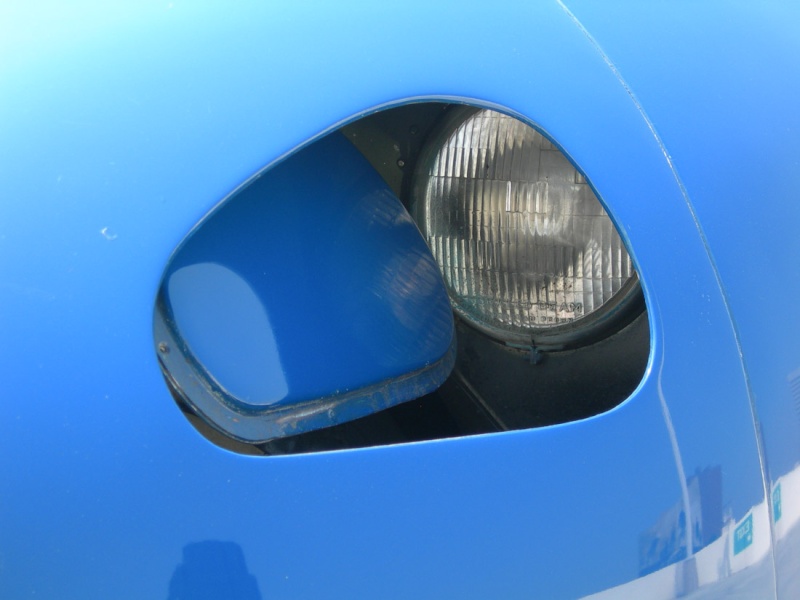
Let's Get The Word Out!
We want to thank you for checking out our page. Any amount you contribute is greatly appreciated. Even if you can't contribute by donating money, we'd still love your help:
Please share this page to anyone you think will find it interesting.Anyone who is a fan of Los Angeles, Cars, Engineering, Entrepreneurs or History will love and appreciate Gary Davis' story.
-Thanks!
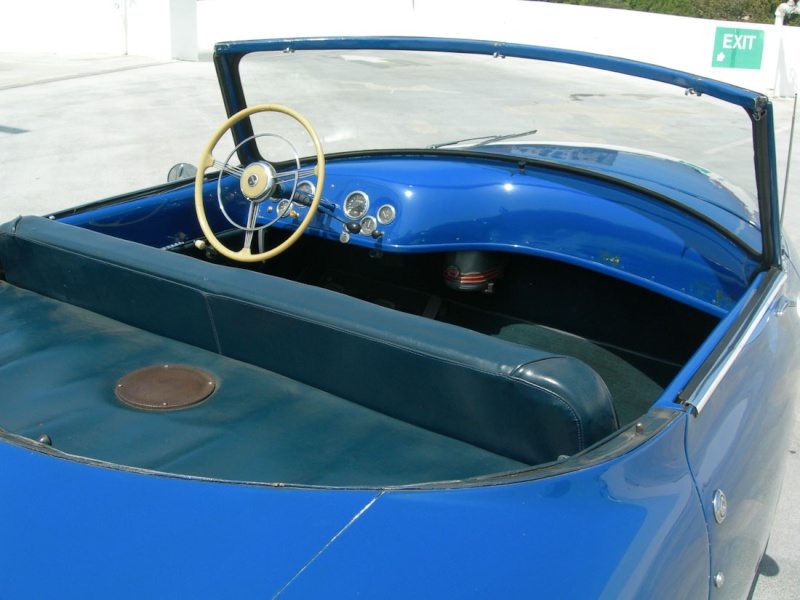
https://www.indiegogo.com/projects/let-s-build-this-3-wheeled-car-together
We at the Petersen Automotive Museum want to work with the Indiegogo community to restore this 3-wheeled 1948 Davis Divan back to its original glory. We're hoping to raise $30,000 in order to do so.
The Petersen is a 501(c)(3) non-profit automotive museum located in Los Angeles, Ca.
This Davis is 1 of only 17 ever built. It was one of only a handful of rare cars to be made in Los Angeles.
If we achieve our goal, we will be able to restore the Davis back to its original color and make it as authentic as the day it was built.

Our Davis Divan we're crowdfunding the restoration of was featured on Jay Leno's Garage

A Little Bit of History
After World War II, dozens of entrepreneurs formed companies to manufacture automobiles to meet the pent-up demand for new cars. Gary Davis built and promoted a particularly unusual car with aircraft-inspired styling, disappearing headlights, four-abreast seating, aluminum body construction, and the simplicity of three wheels. It was touted as the car of the future. Due to postwar material shortages and a lack of capital, Davis could not realize his dream of mass-producing his car and only about 17 vehicles were built in a hangar at the Van Nuys Airport. Impatient investors and would-be dealers and buyers who had put deposits on cars they never received, brought legal action against Gary Davis. Though convicted of fraud, Davis steadfastly maintained his innocence for the remainder of his life.

We Have Great Perks For All Donation Levels
Some of the perks range from a detailed e-book documenting the restoration, to custom logo shirts and stickers.
You can even have your name displayed next to theDaviswhile it is on display in the Petersen!
If you live locally, some of the perks include visiting the car inperson, coming to the unveiling party, and you could even get a ride in the car.

The Impact of This Build
If we successfully fund this campaign, it could change the way museums fund projects in the future.
Your contribution will be permanently attached to this historic vehicle.
We've restored cars in the past, but never like this. A successful Indiegogo campaign will mean the Petersen would be able to restore and display more cars in the future and at a faster rate.
We need the Davis fully restored by December 1, 2015. That's the day our museum will reopen to the public. It's going to be a very exciting couple of months restoring and preparing this car for our opening.
The Davis will be the centerpiece of the "Innovation" part of the museum. We feel the design of the car and engineering is one of the best examples of "Innovation" from this period.

Let's Get The Word Out!
We want to thank you for checking out our page. Any amount you contribute is greatly appreciated. Even if you can't contribute by donating money, we'd still love your help:
Please share this page to anyone you think will find it interesting.Anyone who is a fan of Los Angeles, Cars, Engineering, Entrepreneurs or History will love and appreciate Gary Davis' story.
-Thanks!

https://www.indiegogo.com/projects/let-s-build-this-3-wheeled-car-together
_________________
We don't care the People Says , Rock 'n' roll is here to stay - Danny & the Juniors - 1958
 Re: 1948 Davis Three Wheels
Re: 1948 Davis Three Wheels
_________________
We don't care the People Says , Rock 'n' roll is here to stay - Danny & the Juniors - 1958
 Re: 1948 Davis Three Wheels
Re: 1948 Davis Three Wheels
_________________
We don't care the People Says , Rock 'n' roll is here to stay - Danny & the Juniors - 1958
 Re: 1948 Davis Three Wheels
Re: 1948 Davis Three Wheels
_________________
We don't care the People Says , Rock 'n' roll is here to stay - Danny & the Juniors - 1958
 Re: 1948 Davis Three Wheels
Re: 1948 Davis Three Wheels
_________________
We don't care the People Says , Rock 'n' roll is here to stay - Danny & the Juniors - 1958
 Re: 1948 Davis Three Wheels
Re: 1948 Davis Three Wheels
Je n'ai pas lu tout l'article, mais j'ai vu une fois une émission où il était question de cette auto.
C'est un gars qui s'appelle Wayne Carriny (ou quelque chose comme ça), et qui s'est spécialisé dans la recherche, l'achat, restauration et revente de modèles rares.
Dans une de ces émission, il était question d'une Davis motorisée par un Flathead Ford, apparemment monté d'origine, et apparemment la seule à en être pourvu.
C'est un gars qui s'appelle Wayne Carriny (ou quelque chose comme ça), et qui s'est spécialisé dans la recherche, l'achat, restauration et revente de modèles rares.
Dans une de ces émission, il était question d'une Davis motorisée par un Flathead Ford, apparemment monté d'origine, et apparemment la seule à en être pourvu.
_________________
Rien ne vaut le son du V8 le soir au coin du bois.
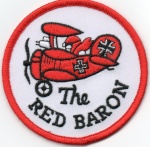
The Red Baron- Messages : 741
Date d'inscription : 01/07/2014
Age : 56
Localisation : Bordeaux
 Sujets similaires
Sujets similaires» Beatnik Bandit - 100% Hot Wheels detailled collectible - Hot rod show rod bubble top - Ed Roth - Hot Wheels
» Cadillac Eldorado 1957 custom Kustom lead sled - 100% Hot Wheels - John d'Agostino - Hot Wheels
» Chevy 1949 - 1952 customs & mild customs galerie
» '32 Show rod St James Davis
» 1952 Chevrolet - Bob Davis
» Cadillac Eldorado 1957 custom Kustom lead sled - 100% Hot Wheels - John d'Agostino - Hot Wheels
» Chevy 1949 - 1952 customs & mild customs galerie
» '32 Show rod St James Davis
» 1952 Chevrolet - Bob Davis
Permission de ce forum:
Vous ne pouvez pas répondre aux sujets dans ce forum
 Connexion
Connexion






